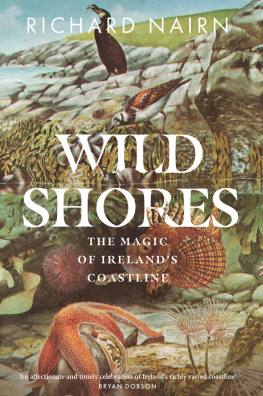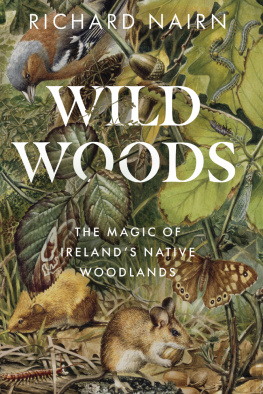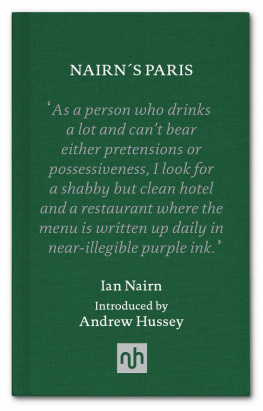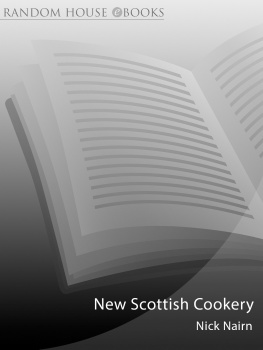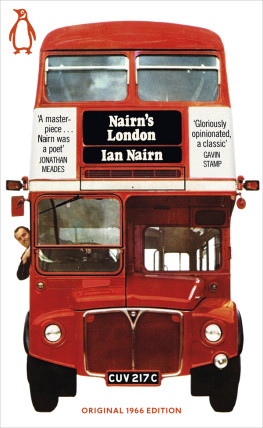Ian Nairn - Nairns Paris
Here you can read online Ian Nairn - Nairns Paris full text of the book (entire story) in english for free. Download pdf and epub, get meaning, cover and reviews about this ebook. year: 2017, publisher: New York Review Books, genre: Detective and thriller. Description of the work, (preface) as well as reviews are available. Best literature library LitArk.com created for fans of good reading and offers a wide selection of genres:
Romance novel
Science fiction
Adventure
Detective
Science
History
Home and family
Prose
Art
Politics
Computer
Non-fiction
Religion
Business
Children
Humor
Choose a favorite category and find really read worthwhile books. Enjoy immersion in the world of imagination, feel the emotions of the characters or learn something new for yourself, make an fascinating discovery.
- Book:Nairns Paris
- Author:
- Publisher:New York Review Books
- Genre:
- Year:2017
- Rating:4 / 5
- Favourites:Add to favourites
- Your mark:
- 80
- 1
- 2
- 3
- 4
- 5
Nairns Paris: summary, description and annotation
We offer to read an annotation, description, summary or preface (depends on what the author of the book "Nairns Paris" wrote himself). If you haven't found the necessary information about the book — write in the comments, we will try to find it.
Nairns Paris — read online for free the complete book (whole text) full work
Below is the text of the book, divided by pages. System saving the place of the last page read, allows you to conveniently read the book "Nairns Paris" online for free, without having to search again every time where you left off. Put a bookmark, and you can go to the page where you finished reading at any time.
Font size:
Interval:
Bookmark:

Ian Douglas Nairn (19301983) was a British architectural critic and topographer. He coined the term subtopia for the areas around cities that had in his view been failed by urban planning, losing their individuality and spirit of place. In the 1960s, he contributed to the volumes on Surrey and Sussex in Nikolaus Pevsners Buildings of England series, and published Nairns London and Nairns Paris as well as presenting several BBC TV series. His work has influenced writers as diverse as J. G. Ballard, Will Self, Iain Sinclair and Patrick Wright.
Andrew Hussey is Professor of Cultural History in the School of Advanced Study, University of London. He is a regular contributor to the Guardian and the New Statesman and the writer/presenter of several documentaries for BBC TV, BBC Radio 4 and Channel 4. He is the author of The Game of War: The Life and Death of Guy Debord (2001), Paris: The Secret History (2006) and The French Intifada: The Long War Between France and its Arabs. He was awarded an OBE in 2011 for his services to cultural relations between the United Kingdom and France. He lives in Paris.
Andrew Hussey
I first started reading Nairns Paris whilst drinking a beer in a caf called Chez Charly on the rue Raymond-Losserand in the 14th arrondissement of Paris, where I have lived for the past ten years. This isnt the real name of the caf but this is what locals call it in homage to Charly, a once-legendary previous owner of the place. It isnt quite a dive but it isnt quite as respectable as it seems from the outside, where passing tourists sit on tidy terrasses sipping coffee or drinking beer. Inside, on any given evening you are likely to come across a sprinkling of local small-time gangsters, mainly North-African or Portuguese, some elderly prostitutes and a former, now repentant drug dealer from somewhere in Eastern Europe whose cockney accent was acquired during several years doing time in English prisons. Its the kind of place where you could easily imagine Ian Nairn enjoying the atmosphere, necking down a Leffe and giving his shy, diffident but always definitive views on his surroundings.
In fact, as a quick glance at the back end of this book reveals, Ian Nairn had already been around here almost fifty years ago if not to this particular zinc, but to this quartier, usually called le Village Pernety after the nearby Mtro station. He called it the grey backside of Montparnasse and came here specifically to look at an obscure but intriguing church, a few minutes walk away from Chez Charly, called Notre Dame du Travail.
The church is situated on the rue Vercingetorix. Even now, this place is not particularly easy to find its certainly a fair way from the classic sights of central Paris. In the mid-1960s, when Ian Nairn was here, the area was low rent and dilapidated, just about to be redeveloped into a new autoroute for the coming decade, and so messy and unloved. Nonetheless Nairn found his way here and discovered what he called the gayest of all the iron churches in Paris. He described it in this way because of a very specific architectural fact the church is extremely unusual for its period (it was finished in 1902) because, as Nairn explains, it makes not the slightest concession to Gothic detail Instead, the piers are I-beams, expressed down to the bolts, the struts in between are as thin as technology could make them. It feels like a train shed, but here the space is given direction.
The point that Nairn is making, in a slightly oblique way, is that with this singular technical detail the architectural style of this church is suddenly at a remove from the late nineteenth century when even the likes of such forward-thinking architects as Louis-Auguste Boileau felt the need to nod to the Gothic past. As such Notre Dame de Travail (Our Lady of Work) announces a new pseudo-industrial aesthetic, in line with the needs of the predominantly proletarian worshippers of the parish, and so ready for the twentieth century. It is the architecture which reveals the wider sweep of history. This is typical Nairn clever, poetic but never showy. He is an excellent teacher.
By the time he wrote this book, Nairn was in his late thirties. By now he was already known to the British public for his opinions and for being opinionated. Although he had started his career writing for the specialist journal Architectural Review, he was equally at home in the pages of the Observer or on the BBC. He had made his name in 1955 with a special issue of Architectural Review called Outrage which attacked the creeping banality of the British landscape which he called with disgust subtopia. His arguments struck a chord with a non-specialist readership and were soon published as a book.
His big idea was that architecture, although all too often conceived by theorists, is actually about daily life, where people really live and how they live. Nairn himself kept his distance from architects, although his work was increasingly influential on them. Instead he travelled, drank and wrote books like this, which were meant to be not an invitation to argument but to discovery.
He is famous for nosing out neglected or forgotten parts of a city indeed this is what makes Nairns London and Nairns Towns, the companion volumes to this book, such marvels. And this is indeed why so many contemporary writers on the city Iain Sinclair, Jonathan Meades, Owen Hatherley, Will Self: take your pick admire him. It would be obvious to invoke the term psychogeography at this point a term often used by Nairns present-day admirers to justify his relevance. This is not entirely wrong but as you walk around Paris reading this book which you should then it is also worth remembering that the term psychogeography was actually coined here in the 1950s by a group of avant-garde fanatics called the Internationale situationniste. This group was led by the writer and drinker Guy Debord who invented the word after eating too much hashish (he ate it rather than smoked it to copy his hero Charles Baudelaire) and who spent a stoned night in the Jardin Des Plantes. Nairn had almost certainly never read Guy Debord, nor heard of the Situationnistes. But he shared with them a desire to be intoxicated by the city; they also liked a drink and knew how important it is to be sometimes literally intoxicated by and in the city.
Like Nairns London, the present book has a double-edged quality: yes, it takes you to places that you would never have guessed existed but it also teaches you to look at familiar sites again, in a way that often reveals new, hidden realities. Here he is, for example, on the Eiffel Tower: It must represent Paris for millions; and it is a well-deserved piece of luck that the Eiffel Tower is very good as well as very tall. Eiffel conceived it with true nineteenth-century gusto France will be the only country to have a flagstaff three hundred metres high but also with nineteenth-century civility, comprehending and compassionate. Never for a minute does the tower bear down on the city or its visitors; never does it endorse the puniness of man. Instead it enlarges the viewer, gathers him up in its colossal size () and declares that the sky is not terrifying at all but was meant for our enjoyment along with Pernod and Coquilles Saint-Jacques.
This is one of the best, and most accurate descriptions I have ever read in any language of how and why the Eiffel Tower was built, and what it actually does in the city. Like most people who live in Paris, I love the Eiffel Tower and, although I almost never go to the park where it lives, I never tire of its presence which is visible almost everywhere in the city from the heights of working-class Belleville to the bourgeois Grand Boulevards. This includes even proletarian Pernety: from the top of a small hill which is Place de Catalogne you can see what a graceful structure it really is, and how it elevates the Paris basin. A good number of the construction workers who actually built the Eiffel Tower many of them Catalans or Portuguese lived here and worshipped in Notre Dame de Travail; this is of course the kind of narrative logic that Ian Nairn so cherished in the cities he admired.
Font size:
Interval:
Bookmark:
Similar books «Nairns Paris»
Look at similar books to Nairns Paris. We have selected literature similar in name and meaning in the hope of providing readers with more options to find new, interesting, not yet read works.
Discussion, reviews of the book Nairns Paris and just readers' own opinions. Leave your comments, write what you think about the work, its meaning or the main characters. Specify what exactly you liked and what you didn't like, and why you think so.



